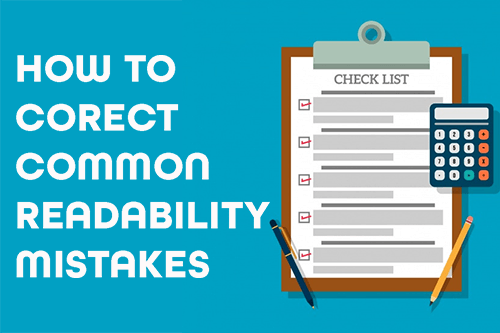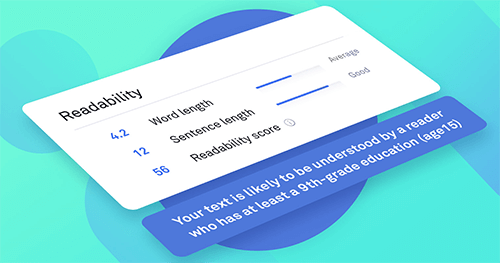SEO Content Readability: The Finer Details You Might Miss
SEO Content Readability is a tricky thing to master, no matter how long you’ve been doing search optimization. Even if you use all of the right tools and make sacrifices to Grammarly, you’re probably missing some common mistakes.
This post will show you the most common mistakes and how to fix them by focusing on human readability. Because we hate writing about unattainable methodology and over bulking how-to posts.

Defining SEO Content Readability
Essentially, SEO content readability is all about how you write information and how easy it is to understand. Nobody has time to read posts chock-full of jargon and academic language anymore, so you need to write simply.
There are many tools and methods to calculate readability, but they don’t account for the human touch. In this blog, we’ll review the common mistakes and how to fix things while you’re crafting the perfect answer to search queries.
What is a Content Readability Score?
Readability refers to the level of ease people will experience to understand a written text. Most tools focus on these factors to rate your SEO readability:
- Speed of perception – how quickly can someone get the point?
- Perceptibility at a distance – can your user understand the intent from a glance?
- Perceptibility in peripheral vision – is the information easy to follow?
- Visibility – how easily can they read your post?
- Reflex blink technique – when they blink, can they still follow?
- Rate of work (e.g., reading speed) – how quickly can they read your text with simple language?
- Eye movements – can they easily navigate by skimming?
- Fatigue in reading – are you using too many techniques that get tiring?
What is Human Readability?
According to experts, writing for humans is the best way to rank effectively. They claim that greater reading ease improves user experience, increases your chances of ranking in voice search, and appeals to search engines looking for human attuned content.
In many cases, this can be directed back to what Neil Patel says good content should be about:
- Solving a problem;
- And appealing to the end-user first.
Why Is It So Important?
Focusing on readability for humans is key to your site’s survival in search engine ranking pages. Your reader is not the robot crawling the web but a person looking for linguistic cohesion. In other words, you should focus on-page experience and the takeaways from your text.
To quote Nick Slater: “Writing with only a search engine’s interests in mind results in ‘…a masterpiece by SEO writing standards and an absolute turd by regular writing standards.’”

Common Mistakes in Content Readability
1. Lose Clickbait Titles
Everybody wants to shock a user into clicking, but we’re all so used to it that we move onto other pages. Nobody likes YouTube videos with titles that grab attention but aren’t related to the subject matter.
The same goes for any blog, page, or post you’ve written to shock someone into clicking. We don’t trust news sites that use clickbait, and the same is true for others.
So, instead of aiming for the most shocking thing to put in your title, write something thought-provoking without “ultimate,” “revealed,” or “revolutionary” information. The same goes for titles “guaranteeing” success as a result of slogging through the article.
However, a little showmanship is okay if you keep it down to earth and fulfil your promises. Meet expectations succinctly and follow your instincts of being a human.
2. Resist Keyword Stuffing
We want to rank for every keyword imaginable, but that makes your content hard to read and understand. When you’re focusing on SEO readability, stuffing in variations to hit that sweet spot gets tiring for your reader.
For example, if I had stuffed every variation of readability into the first few paragraphs of this post, you’d have clicked away:
By focusing on SEO content readability, you’ll make your text more readable to search engines looking for ease of reading. Natural language is easier to follow and less likely to jar your end-user out of the point of your text. Readability scores help, but only to a point for many search engines.
See what I did there? My brain is already fatigued, and I have no further interest in what I wrote. Keyword density is well and good, but placement is now what matters.
3. Stop Over-Paragraphing
Line breaks and other formatting styles are throwing off your users, like micro-paragraphs. Cutting off your sentences can be especially jarring if used inefficiently.
We’re serious here (so effective, right?).
Try to analyze the time and place when this method will be effective instead of using it for shock value. Cliff hangers should remain in novels and canceled streaming service flops no one wanted.
Overdoing the line breaks and short sentences or overdoing emphasis can be detrimental to your post. Another consideration is the font type and size you use – people find it easier to follow the text on a screen if it’s sans-serif.
4. Just Stop Writing Out How-To Posts For No Reason
People often search for things, and you have probably performed a lot of mental gymnastics to answer those queries. It’s important to keep in mind that you can’t write a lengthy piece waxing lyrical about how to do something.
Yes, that was a dig at WikiHow, but they have perfected the art of creating simple steps to follow. So, instead of huge paragraphs explaining every tiny detail, try to summarize.
Insert a descriptive sentence, then expand any finer points someone needs to know. After that, leave it alone and move onto the next point.
5. Resist Over-Formatting
“Skimmability” is the newest buzzword dogging our every nightmare and manifests as over-formatting. In some cases, headings are larger, in a different font and color, and drawing attention. Or your paragraphs have too little space between the lines.
- Italicizing one or two words doesn’t hurt
- Breaking some text into bullet points is okay
- Occasional bolding can call out information well
But if most of your text is hyperlinked and your headings are overwhelmingly formatted with five different fonts at play, you’ll lose someone’s interest. Skimmable content should never be busy content when it comes to readability.
6. Link Responsibly at All Times
Links are a niggling reminder to your user that they need to read more, but overlinking can hinder your site when overused. Most SEO content readability experts recommend keeping it to a minimum and only linking what’s relevant.
It might be tempting to follow your competitors and overdo it, but you’ll lose many on-page views. So, pare it down to where you can keep things relevant without causing click anxiety.
After all, a large part of SEO these days involves strategy and care to keep your page experience up to standard.

SEO Content Readability: Key Points
Unfortunately, SEO is no longer formulaic and dependent on search terms. The main pillar of good content is about mindset and writing choices.
The algorithms defining your statistics are clever now, and you need to keep up without making the same mistakes. All you need to do is ensure that people don’t hate reading what you have to say!
Comment below if you found anything interesting about our six points to improving content readability!


